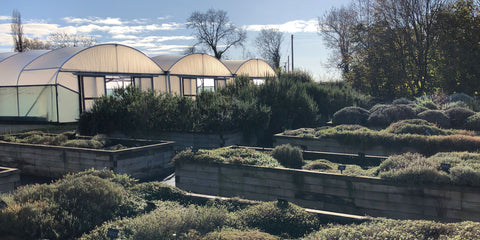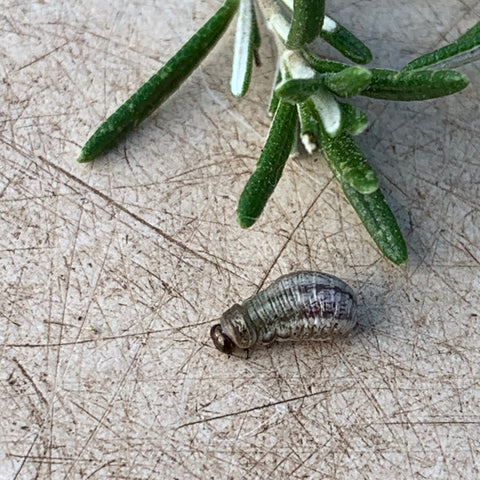Walking around Jekka's Herbetum you can see that Spring is now around the corner; I noticed, this week, that the Wild Garlic is just emerging. As the ground is too cold and in many cases too wet to work on, now is the ideal time to start looking through your seed packets and planning the season ahead. You can also start taking cuttings, dividing herbs and potting up container herbs. Hopefully you have read our blog about what to do in Autumn and have put your garden into hibernation for the festive period; if not you still have time to do the last tidy up before the busy season begins.
This blog is part of the ‘Jekka’s Seasonal Tips’ series that includes late spring, summer, and autumn and winter. Together they form the basis of Jekka’s guide on how to grow herbs.
Jekka's top tips for growing herbs in early spring
With climate change and the changes in weather patterns it is difficult to advise what you should be doing from one day to the next, you have to be adaptable to cope with the changes. As a sustainable and environmentally conscious herb farm we are particularly susceptible to the ‘unusually warm period’ or the ‘sudden cold snap’ with which the typical gardener has to contend. The prediction is that, due to climate change, there will be an increased frequency of the extremes and therefore, we need to be ever alert and ready with the fleece or watering can.
As the festive period was particularly warm, we experienced a bit of botrytis cinerea, often called grey mould. This is a fungal infection which can often be found growing on old flowers. It easily spreads to neighbouring plants once formed and greenhouses provide an ideal moist, temperate environment for it to grow. Therefore, it is advisable to have a look and carefully cut off any infected stems or dead flowers. Also do not leave any dead material lying around. To reduce humidity increase the ventilation. Here we open the doors of the glasshouse once the outside temperature reaches 7 Deg C during the day.
As the weather warms and the days get ever longer life becomes more abundant and apparent in the garden. However, this year, with our unusually warm weather, life never really went away as it used to and our spring bulbs and garlic are already breaking through the soil and the sap can be seen rising in the trees; did, what we know as winter, actually happen this year? Perhaps this is the new normal that we must work with. However, as any diligent gardener will know, a warm winter, might mean a cold February/March so we should be on our toes to protect tender herbs or new growth with horticultural fleece.
Jekka's top tip is, until we get through March, to be prepared to cover new young plants with horticultural fleece at night if temperatures drop below 0 Deg C.
In the early spring, late winter, there are plenty of things to be getting on with in the garden. To start with, you can have the final tidy up before the busy season starts. We have been cleaning down our hardstandings by power washing simply with water. We do this every year as it removes any unwanted weeds, pests and diseases.
Want to know more? Read Jekka's top tips on being a sustainable gardener.

Fresh herbs are available for use in the kitchen.
By providing a little protection you can soon start having fresh herbs available: for example, there will be new shoots of Angelica, as well as Bay, Chervil, Italian Marjoram, Rosemary and Sage; Sorrel has started coming through along with Salad Burnet and small pickings of Winter Savory; Thyme, especially lemon thyme, and Parsley are also around. Chives start to come up if under protection, and Mint can be available if forced. For the foragers, Wild Garlic is just showing. As with everything else it is early this year.
Want to start a culinary herb garden? Check out Jekka's blog on how.
It is time to start planning and sowing your herb seeds.
Jekka’s top 15 seeds for sowing in early spring, in the cold under protection, not in the garden, include:
-
Amaranth (Amaranthus tricolor 'Red Army'): an ancient grain whose seeds are of nutritional benefit as they are high in protein and fiber. The young leaved are great in salads.
-
Borage (Borago officinalis): although hairy on the plant, the hairs dissolve in the mouth and the flavour is of cool cucumber. Alternatively freeze the flowers in ice cubes and use in your summer Pimms.
-
Celery leaf (Apium graveolens): the young leaves are delicious in salads or when added to mash potato.
-
Rhubarb Chard (Beta vulgaris 'Ruby Chard'): the leaf can be eaten when young directly in salads or older leaves can be blanched like spinach.
-
Chicory (Cichorium intybus): add young leaves and flowers to summer dishes or use forced leaves in a winter salad. Braise chicons in butter as a vegetable dish.
-
Coriander (Coriandrum sativum): both the seeds and leaves are edible, the seeds are warmly aromatic and the leaves have an earthy pungency.
-
Cornflowers (Centaurea cyanus): the petals of the cornflowers are edible and look attractive scattered over a green salad.
-
Fennel (Foeniculum vulgare): the seeds can be used in sauces and breads, the leaves in salads, with cooked vegetables or oily fish and the young stems as an extra crunch in salads.
-
Heartsease (Viola tricolor): the flowers are edible and look attractive in fruit salads or frozen in ice cubes for your summer cocktails.
-
Pot Marigold (Calendula officinalis): this sunny little flower is edible and has a nutty taste; it is good in salads, omelettes or sweet marigold buns.
-
Purslane (Portulaca oleracea): the leaves of purslane are quite remarkable and have the flavour and texture of fresh mangetout.
-
Poppies (Papaver rhoeas): the ripe seeds are often used in the baking of breads, cakes or biscuits to add a pleasant nutty flavour.
-
Red Orach (Atriplex hortensis var. rubra): an attractive border plants whose young leaves can be used in salads or older leaves, blanched like spinach, can be used as a vegetable or in a soup.
-
Red Frills Mustard (Brassica juncea 'Red Frills'): the mustard leaves have a distinctive warm peppery taste and the flowers have a mild mustard flavour. Great added to sandwiches; especially with pork.
- Sorrel (Rumex acetosa): Excellent herb to experiment with, use in soups, omelettes, fish sauces and with poultry and pork.
See Jekka’s top culinary herb seeds or browse the entire collection as well as Jekka’s how to video on sowing seeds for more information.
Want to know more? Read more about culinary herbs in Jekka's Guide to Culinary Herbs or try some of our herb-based recipes.

Perfect moment to propagate your herbs
You can take root cuttings of Mint, French Tarragon, Bergamot, Tansy, Jiaogulan (Sweet Tea Vine), Sweet Woodruff and Sweet Cicely.
You can divide herbaceous perennials such as Yarrow, English Mace, Mint, French Tarragon, Lovage, Sorrel, Sweet Cicely and Lemon Balm. If you are reading this after a cold period, make sure they are not too frozen and are given added protection after replanting.
If you would like more hands-on practical information on taking cuttings, sowing seeds or dividing herbs check-out Jekka’s Master Class on How to Grow Herbs or, if you wish to start a family herb patch, try our new 'Sow it, Grow it. Eat it.' Master Class for adult and child.

Care and prepare your herbs
Maintain your plants in containers. If the containers have been brought in for the winter or protected against a wall or with fleece, new life might be starting. Help them along by ensuring all old, dead growth is removed or trimmed back. If required, water, but not too much as over-watering often causes mould and botrytis, and feed with liquid seaweed. Re-pot if necessary, into containers for display later in the season.
Prepare the garden by raking over the soil to disturb any early weeds and, if your soil is alkaline (check out Jekka’s Guide to Soil) and you gave it a good dressing of manure in the Autumn, now is the time to dig it in well. Also, remove any black polythene that you might have put down.
It is also time to start checking on your herbs as they wake up from hibernation mode.
Jekka's early spring herb action list
Here is a summary of Jekka's spring, late winter, action list:
- Go on a walk about and check for signs of new life or the appearance of pest and disease. In particular check for the lavea of Rosemary beetle and remove them.
 Rosemary beetle larvae
Rosemary beetle larvae
- Repair, maintain, clean and sharpen your tools - check out our gifts for gardeners, perfect for this coming Valentines or Mother's day!
- Clean the glasshouse, hardstandings, pots, and sowing and propagating equipment. We simply use water.
- Lift any terracottas as we are starting to have frosts.
- Clean up any leftover debris or dead plants.
- Install water butts and start collecting water.
- Create a composting area.
Want to know more?
You can find more ideas in Jekka’s blog and videos as well as Jekka's book 'A Pocketful of Herbs' or Jekka's Complete Herb Book, browsing Jekkapedia and exploring our herb based recipes.
Alternatively, come and visit the herb farm in South Gloucestershire at one of our Open Days, Master Classes or Herb Experiences (see our events calendar).
Herb plants are available and you can organise a collection from our herb farm in South Gloucestershire or at one of our Open Days. Please see our 'Looking Good List' for availability and use our webform or email your list directly to us (sales@jekkas.com). We no longer offer a general mail order service for our plants but we do offer a limited selection of Jekka's Culinary Herb Boxes.
Ensure you subscribe to our newsletter to find out what we have in store for the year.



